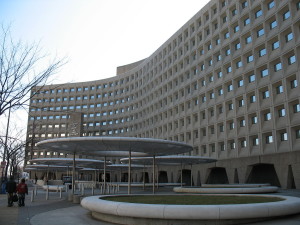Some federal employees might feel brutalized by the buildings they work in
Housing and Urban Development Secretary Julian Castro joked that in trying to make HUD a better place to work, he could do little to change the appearance of the...
From the soundproof booth of Federal News Radio, the federal government and all its travails and triumphs can seem like abstractions. The guests come on, they hang up the phone and it’s on to the next segment. That’s why I like to get the heck out of here and see an actual agency in person now and again.

I’ve found you can learn a lot by observing the surroundings, the gait of the people working in and around an agency, the way the interiors look.
During my visit to the Department of Housing and Urban Development, Secretary Julian Castro joked that in trying to make HUD a better place to work, he could do little to change the appearance of the headquarters building. It indeed is ugly, with little help from the broad plaza in front populated not by trees but by decaying, weird-looking flying saucers. You might be surprised to find it was considered something of a masterpiece of modernism — specifically the brutalism branch — when it opened in 1968, having been designed by no less than Marcel Breuer, according to the General Services Administration.

The day I visited, temperatures reached the 90s with high humidity. No fun walking back and forth across the front of the building trying to find the correct door. The young guard, though, was perky and friendly. Because I had time to kill, she directed me ‘round back —“follow the holes,” she said, referring to archways — to an adjacent structure with a large food court.
If any place has the potential for soul-killing, it’s the HUD building and its setting in a slightly desolate patch of Southwest D.C. with practically no street-level retail attraction. The whole area is genteely worn, almost shabby with mostly concrete surfaces.
My college’s then-new campus, Rochester Institute of Technology, was designed and built in the same era, opening in 1966. It, too, is in the Brutalist style, only with brick exteriors and concrete interiors. Yet I had a great time there, and the “Brick City” background provided a comic counterpoint to collegiate antics. I suspect that for HUD employees, the frumpy building provides some reverse pride in persevering in an ugly environment.
Visiting the Food and Drug Administration in Silver Spring in late winter with snow on the ground, my impression was “Disneyland” — impenetrable, surrounded by vast parking lots. I was there to interview then-Commissioner Peggy Hamburg. Growing anxious, I couldn’t find a parking space within a mile. I went into a garage and bread-crumbed my way to the heavily guarded front door. When you’re a federal agency, every visitor looks like a terrorist.
Once in, FDA presented a modern, lively interior. Because it consists of new and old buildings, it’s nearly incomprehensible to navigate. But there are lots of windows, up-to-date furnishings and people marching purposefully to and fro. Once in, you’re in to stay. I figure you’d need 30 minutes of a lunch hour for navigation in and out of the campus.
The Equal Employment Opportunity Commission presents another type of environment. Located in the former warehouse of Woodward & Lothrop (Woodie’s to locals), it sits in the heart of D.C.’s urban renewal. CIO Kimberly Hancher, to whom I’d offered to bring lunch, directed me to the new Harris Teeter across the street, where I stood with what looked like a dozen federal denizens in the sub line. Inside, EEOC looks like fairly standard federal offices, nothing fancy but new enough to not yet have that beaten-down look. The surrounding neighborhood offers a streetscape with dog-walking hipsters and lots of places to go.
After work at HUD or FDA, there’s nowhere to go but outa there. Leaving EEOC, you emerge in a neighborhood you wouldn’t mind hanging around in.
Copyright © 2025 Federal News Network. All rights reserved. This website is not intended for users located within the European Economic Area.
Tom Temin is host of the Federal Drive and has been providing insight on federal technology and management issues for more than 30 years.
Follow @tteminWFED







